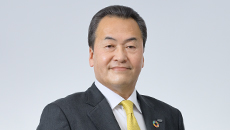To our shareholders and investors

We would like to begin this message by expressing gratitude to our shareholders and investors for their ongoing support.
1. Operating and financial review
Consolidation period and comparative information due to the change in fiscal year-end
Effective from the fiscal year ended December 31, 2024, the fiscal year-end (the closing date of the fiscal year) of the Company has been changed from March 31 to December 31 every year. The fiscal year ended December 31, 2024, a transitional period to implement the change in the fiscal year-end, ran for nine months (April 1–December 31, 2024) for Daifuku Co., Ltd. and its subsidiaries in Japan, while subsidiaries outside of Japan had a 12-month accounting period (January 1–December 31, 2024). Accordingly, quarterly consolidated financial statements for the first three quarters of the fiscal year ended December 2024 have not been prepared. Therefore, a comparative analysis with the same period of the fiscal year ended December 31, 2024 has not been conducted.
During the first three quarters of the fiscal year ending December 31, 2025, the global economy generally remained favorable, although uncertainty increased due to the impact of US trade policy and downside risks associated with the sluggish Chinese economy.
Looking at the business environment for the manufacturing and distribution sectors in Japan and the United States, investment in automation at manufacturing and logistics sites is recovering against the backdrop of labor shortages and substantially higher labor costs. In the semiconductor industry, strong demand for advanced semiconductor investment including automation in back-end processes continues, supported by increasing demand for AI applications. In China, investment continues in line with efforts to strengthen and promote domestic production. In the automotive industry, while customers have delayed investment decisions as they await the impact of tariffs, a high level of investment continued to be planned, mainly in the United States. Meanwhile, demand for investment in automation at airports to meet the increase in the number of air passengers continues, particularly in the United States and certain other countries.
In this economic and business environment, during the first three quarters of the fiscal year, orders for automotive systems were sluggish, while orders for intralogistics systems from manufacturers and distributors, cleanroom systems from the semiconductor sectors, and airport systems remained steady. Sales remained strong, supported by a favorable performance in intralogistics systems, cleanroom systems, and automotive systems, which benefiting from an extensive order backlog at the end of the previous fiscal year.
Specifically, the Group received orders of 499,040 million yen, and recorded sales of 486,014 million yen.
In terms of profits, the profit margin remained at a high level due to cost reductions achieved through production efficiency improvements and enhanced project management, as well as a focus on securing orders with strong profitability.
Consequently, the Group posted operating income of 75,214 million yen, and ordinary income of 77,556 million yen. Net income attributable to shareholders of the parent company was 58,468 million yen. These results already exceed the record-high results of the previous fiscal year, which included operating income of 71,546 million yen, ordinary income of 74,498 million yen, and net income attributable to shareholders of the parent company of 57,086 million yen.
2. Outlook for the fiscal year ending December 31, 2025
| Year ended December 2024 | [Reference] Year ended December 2024 (Japan: 12 months) |
Year ending December 2025 forecast | |
| Orders received | 594.7 billion yen | 653.1 billion yen | 680.0 billion yen |
| Net sales | 563.2 billion yen | 643.9 billion yen | 650.0 billion yen |
| Operating income | 71.5 billion yen | 81.0 billion yen | 97.5 billion yen |
| Ordinary income | 74.4 billion yen | 84.2 billion yen | 102.0 billion yen |
| Net income attributable to shareholders of the parent company | 57.0 billion yen | 64.4 billion yen | 76.0 billion yen |
The above forecast values are our projections based on information available at the time of this release and contain various uncertainties. Actual results may differ materially from forecast values due to factors such as changes in the business performance of the Company.
Note:
Due to the change in fiscal year-end, the fiscal year ended December 2024 was a 9-month period in Japan and a 12-month period outside of Japan. In the table above, "Year ended December 2024" reflects results for 9 months in Japan and 12 months outside of Japan, and "Year ended December 2024 (Japan: 12 months)" is calculated assuming a 12-month period in and outside of Japan.
3. Basic policy for dividends
The Company regards the return of profits to shareholders as its most important management task and adopts a performance-based policy for cash dividends based on consolidated net income. The Company appropriates the remaining surplus to internal reserves for future growth.
In the four-year business plan for 2027, the Company aims to achieve a consolidated dividend payout ratio of 35% or more for each fiscal year to further enhance shareholder returns.
Given the above policy and the favorable progress in the Daifuku Group’s performance, the Company has decided to increase its year-end dividend forecast by 8 yen per share to 42 yen from the forecast previously announced in August. Accordingly, the annual dividend per share is projected to be 76 yen, and the consolidated dividend payout ratio for the fiscal year ending December 31, 2025 is expected to be 36.8%.
We respectfully ask our shareholders and investors for their continued support.
November 2025
Hiroshi Geshiro, President and CEO
